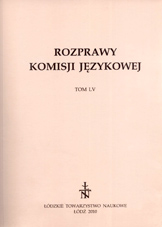Semantyka i struktura ojkonimów i anojkonimów gminy Przykona w powiecie tureckim
Semantics and structure of oeconyms and anoiconyms of Przykona commune, turek district
Author(s): Ewelina ZającSubject(s): Language and Literature Studies
Published by: Łódzkie Towarzystwo Naukowe
Summary/Abstract: The article applies to oeco- and anoiconyms of Przykona commune, their semantics, nameforming motivation and structure. All names, both topographical and proper, are valuable language monuments because they record a history that cannot be fake and language which was used in the past by the residents. The material shows that among local names topographical names dominate, the following are possessive and cultural names, also one menial name was noted. Also among territory names, both land and water, topographical, possessive and cultural names mostly dominate. In the article, there was discussed the problem that most researchers face while analyzing uninhabited names, that is the choice of appropriate classification, both semantic and structural. Frequently, territory names are the same as common names, therefore classifying them according to traditional divisions of Witold Taszycki and Stanisław Rospond and designation of their primacy and secondment proves to be very difficult because each name is secondary in respect to nomen appellativum. Comon terms can function as proper names only in a particular environment or when an object is the only as such in a given area and there is no need for special naming of it. But when there are more objects having the same name on a given area, then prepositional phrase is added to a common term that indicates its location. In Przykona commune many territory names are nominal names that overlap with common terms, for ex. Górka (Hill), Dołki (Holes), Łąki (Grasslands), Borki (Forests), Sosenki (Pine Trees). During field research the researcher – onomastician may encounter many questions concerning proper names because it is not always known whether given name is already nomen proprium or is it still nomen appellativum. But proper names are also different from common terms because they do not have a meaning, they do not mean but indicate. The paper also discusses names in the form of prepositional phrases, compositional names, adjectival names and plural names. All proper names, especially toponyms, are the element of dialect because, due to their individual character and regional and even chronological location, they convey invaluable dialectological data.
Journal: Rozprawy Komisji Językowej
- Issue Year: 2010
- Issue No: 55
- Page Range: 293-305
- Page Count: 13
- Language: Polish

